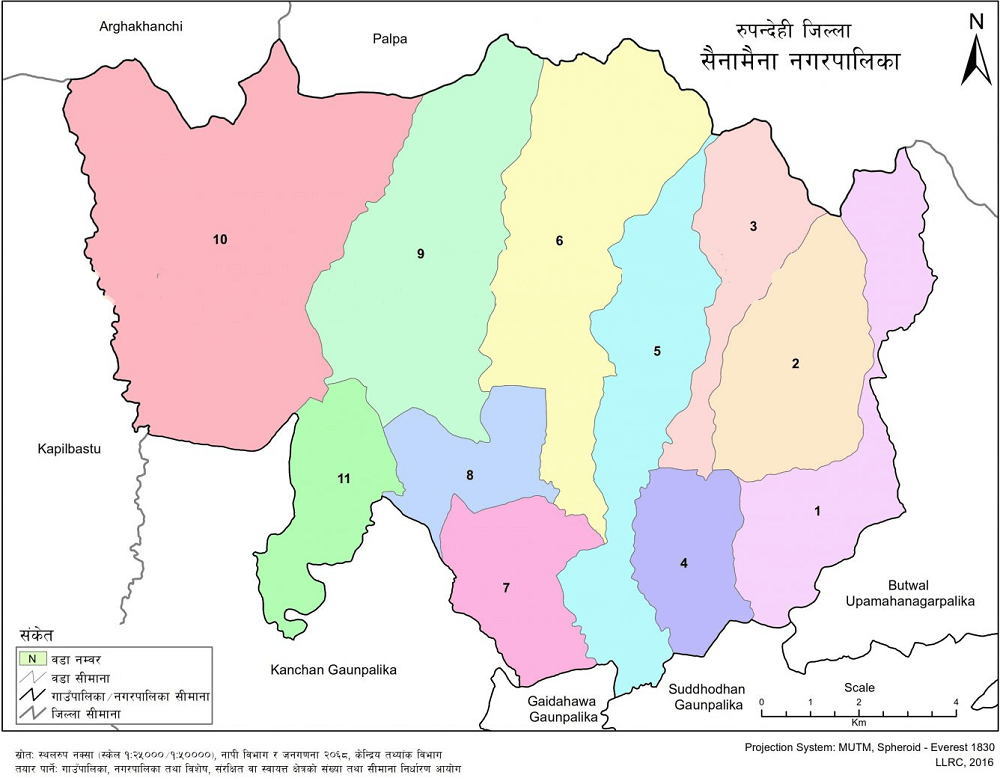Overview
Sainamaina Municipality (Sainamaina Nagarpalika) is located in the northwestern part of Rupandehi district in Lumbini Province. This municipality is situated about 15 km north of Lumbini, the birthplace of the world peace proponent and great human being, Gautam Buddha, nestled in the scenic Chure hills. The municipality is bordered by Butwal Sub-Metropolitan City to the east, Banganga Municipality (Kapilvastu) to the west, Shivaraj Municipality in Arghakhanchi, Rainadevi Chhahara, and Tinau Municipality in Palpa to the north, and Shuddhodhan, Kanchan, and Gaidahwa Municipalities to the south.
The former Parroha and Dudhraksh VDCs were merged to form Sainamaina Municipality on Baisakh 25, 2071 BS. Later, on Falgun 27, 2073 BS, after the state restructuring, the former Saljhundi VDC was also merged, resulting in the greater Sainamaina Municipality. Sainamaina Municipality consists of 11 wards and covers an area of 162.18 square kilometers. According to the national census of 2068 BS, the population of this municipality was 55,822, with a population density of 344.2 per square kilometer. A field survey conducted in 2076 BS reported the population to be 62,697, with a population density of 386.33 per square kilometer.
The East-West Highway divides this municipality into north and south, and the settlement here is a mixture of modern and traditional styles. Within the municipality, there is a blend of various ethnicities, languages, cultures, and traditions. Sainamaina, an area of historical, religious, cultural, and archaeological significance, is one of the hundreds of tourist destinations declared by the Government of Nepal. Sainamaina Municipality was also declared a tourist destination on Kartik 15, 2075 BS.
The southern part of this municipality is predominantly inhabited by indigenous Tharu communities, while the northern region has a mixed population. This municipality's treasures include the historically and archaeologically significant Sainamaina area, the self-originating Shiv Jyotiling Parroha Parmeshwar Bolbam Dham, Malmala Temple, Malmala Chaur Baba, Maherwa Devi, Bolbam Tourist Park, various shrines and temples, Rani Kuwar, Rani Bagaya, Jalaiya Wetland Area, and others. Although most of the municipality's area is covered with fertile agricultural land, the impact of urbanization in recent years has led to the fragmentation of land. The municipality, which is not lacking in forest and watershed areas, is home to more than half a dozen small and large rivers/streams.

Organizational Status of the Municipality
Sainamaina Municipality was initially formed in Baisakh 2071 BS by merging the former Parroha and Dudhraksh VDCs. In Falgun 2073 BS, following the state restructuring, the former Saljhundi VDC was also included, leading to the formation of the larger Sainamaina Municipality. As a newly established local government following the state restructuring, the organizational structure of this municipality is still under development. The municipality currently provides services through its central office and 11 ward offices within the existing structure.
The municipality is performing its duties based on the existing organizational structure, aiming to meet the long-term goals it seeks to achieve and the expectations of the residents. Given the population, service demands, and geographical spread, the current organizational structure appears inadequate. Despite the conclusion of the first term of the elected representatives following the restructuring, the municipality has not yet managed to clearly organize and manage its structure due to various legal and resource constraints.
When considering the responsibilities and services that local governments must provide, the institutional capacity of any local government is dependent on its existing organizational structure and management. Since the organization’s activities are directed through the structure, which in turn determines how employees are deployed and services are delivered, the organizational structure plays a crucial role. The organizational structure of Sainamaina Municipality is still evolving. A detailed organizational and management survey, clearly defining the responsibilities of administrative units, branches, and sub-branches within the municipality, has not yet been completed. The current structure, staffing, workload, state of human resource development, and internal resource mobilization are not clearly defined. However, the municipality is currently functioning with the existing staff from the former VDCs, the integrated employees, and contract staff in a stopgap manner.
Existing Branches within the Municipality:
The current organizational structure of Sainamaina Municipality, as observed, follows the structure recommended by the Ministry of Federal Affairs and General Administration at the time of the municipality's establishment. The structure appears insufficient to meet the responsibilities and service demands based on the population, the pressure from service recipients, and the rights and duties of the municipality. The municipality's work is being carried out by the employees integrated from the former VDCs and various subject offices, although the municipality has not yet been able to conduct a clear organizational and management survey due to legal and policy ambiguities. The current branches and secretariats within the municipality are as follows:
- Administration Branch
- Internal Audit Regulation Branch
- Economic Administration Branch
- Livestock Development Branch
- Revenue Branch
- Agricultural Development Branch
- Planning Branch
- Women and Children Branch
- Infrastructure Development Branch
- Logistics Branch
- Economic Development Branch
- Registration Branch
- Education Branch
- Judicial Secretariat
- Health Branch
- Mayor’s Secretariat
- Land Management and Building Regulation Branch
- Ward Offices
Language Distribution:
- Nepali: 88.16%
- Tharu: 7.08%
- Bhojpuri: 2.62%
- Newari: 1.45%
- Other languages (Maithili, Tamang, Magar, Gurung, Limbu): Remaining percentage
Religion Distribution:
- Hindu: 98.98%
- Buddhist: 0.47%
- Islam: 0.22%
- Christian: 0.08%
- Kirat: 0.22%
- Other religions: Negligible percentage







